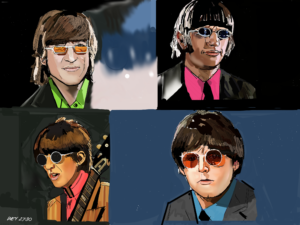Podcast: Play in new window | Download

Musicologist Walter Everett joins professional musicians Cameron Greider and Jack Petruzzelli in a return visit to discuss the latest Beatles reissue set. Revolver is analyzed through the prism of its poetry as well as its musical maturity and what the new set reveals in terms of The Beatles’ major artistic advance.
Check out the upcoming Revolver class here:
This podcast is sponsored by BetterHelp. Visit http://www.betterhelp.com/satb for 10% off of your first month of treatment.


Why does one of the two lead guitar parts on “And Your Bird Can Sing” have more bite or gain than the other? In an earlier episode Jerry Hammack explained that Geoff Emerick would use two different kinds of microphones to compensate for the fact that John and George often played identical guitars through identical amplifiers, thereby varying the quality between the two.
Why does one of the two lead guitar parts on “And Your Bird Can Sing” have more bite or gain than the other? In an earlier episode Jerry Hammack explained that Geoff Emerick would use two different kinds of microphones to compensate for the fact that John and George often played identical guitars through identical amplifiers, thereby varying the quality between the two.
Here is a poignant paragraph from Record Collector’s review for Revolver.
The biggest revelation comes from an unlikely place. John’s home demo for Yellow Submarine reveals that it started life as something entirely different. John repeats variations on “In the place where I was born, no-one cared”, singing in the little-boy-lost voice we’d later hear on Julia and Plastic Ono Band’s My Mummy’s Dead. But this is different: the lyrics here sound like placeholders, words plucked from his subconscious while feeling for the song. He’s John Lennon, it’s 1966, and this is where his mind goes? – it’s utterly heartbreaking. And it puts Yellow Submarine in a totally new light. Paul took his friend’s demo of a song preoccupied with feelings of childhood abandonment and turned it into an escapist fantasy that would become one of the world’s most beloved children’s songs, a song that the young John could’ve found comfort in. It’s their partnership in a nutshell, and excuse me, there’s something in my eye.
That’s what these sets do – they make us think of The Beatles in different ways. Anything that sheds new light on that miraculous music, that gives us more Beatles, can’t be bad. It’s Revolver, turn it up.
What a great review… will always remember this. Reminds of the the story behind Hey Jude, with Paul trying to add some peace to the mess John has made of son’s childhood… Paul seems to have a really tender core under that Godlike status. This was just another epic podcast – thanks Robert and friends, always amazing to tune in! The classes sound so cool!
Here is a poignant paragraph from Record Collector’s review for Revolver.
The biggest revelation comes from an unlikely place. John’s home demo for Yellow Submarine reveals that it started life as something entirely different. John repeats variations on “In the place where I was born, no-one cared”, singing in the little-boy-lost voice we’d later hear on Julia and Plastic Ono Band’s My Mummy’s Dead. But this is different: the lyrics here sound like placeholders, words plucked from his subconscious while feeling for the song. He’s John Lennon, it’s 1966, and this is where his mind goes? – it’s utterly heartbreaking. And it puts Yellow Submarine in a totally new light. Paul took his friend’s demo of a song preoccupied with feelings of childhood abandonment and turned it into an escapist fantasy that would become one of the world’s most beloved children’s songs, a song that the young John could’ve found comfort in. It’s their partnership in a nutshell, and excuse me, there’s something in my eye.
That’s what these sets do – they make us think of The Beatles in different ways. Anything that sheds new light on that miraculous music, that gives us more Beatles, can’t be bad. It’s Revolver, turn it up.
What a great review… will always remember this. Reminds of the the story behind Hey Jude, with Paul trying to add some peace to the mess John has made of son’s childhood… Paul seems to have a really tender core under that Godlike status. This was just another epic podcast – thanks Robert and friends, always amazing to tune in! The classes sound so cool!
Seems to me I read somewhere — either in Recording The Beatles or perhaps the Jerry Hammock book — that there’s no fuzz pedals or overdrive pedals on Revolver, they just cranked the gain on the Vox Superamps they had obtained right before recording the album, and that’s what gets that fuzz tone on AYBCS and SSSS. I know for my Applesauce Project tracks that are meant to be Revolver pastiches I’ve failed to achieve the proper distortion on the guitars. (Also, and again I can’t remember where I read it — the Batiuk Beatles Gear book maybe?) that there are two Casinos on AYBCS.
Seems to me I read somewhere — either in Recording The Beatles or perhaps the Jerry Hammock book — that there’s no fuzz pedals or overdrive pedals on Revolver, they just cranked the gain on the Vox Superamps they had obtained right before recording the album, and that’s what gets that fuzz tone on AYBCS and SSSS. I know for my Applesauce Project tracks that are meant to be Revolver pastiches I’ve failed to achieve the proper distortion on the guitars. (Also, and again I can’t remember where I read it — the Batiuk Beatles Gear book maybe?) that there are two Casinos on AYBCS.